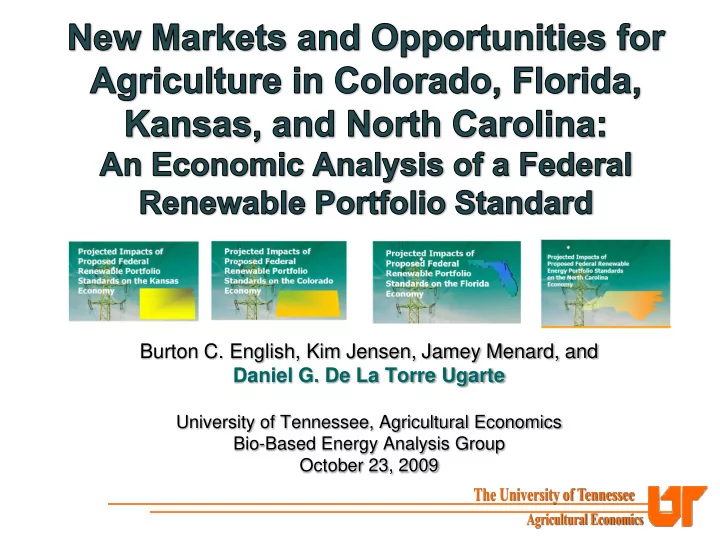

Burton C. English, Kim Jensen, Jamey Menard, and Daniel G. De La Torre Ugarte University of Tennessee, Agricultural Economics Bio-Based Energy Analysis Group October 23, 2009
This Study • Provides an economic analysis of the economic costs and benefits from a Federal renewable energy standard (RES) policy to agricultural counties in Colorado, Florida, Kansas, and North Carolina. • Addresses some key questions: – Impact of RES policy on farm revenue? – Potential of new markets for biomass and how much revenue could biomass sales generate at the farm level? – Direct employment opportunities that result from building out new electric generating facilities? – Job growth on the farm supported by increased biomass production?
RES Policies Considered • Federal RES policies in the 111 th Congress: – 20 percent Federal renewable energy standard (Bingaman) – 25 percent Federal renewable energy (Markey) – Energy savings assumed at maximum allowable levels • Existing state RES policies: – Colorado Renewable Energy Standard – North Carolina Renewable Energy and Energy Efficiency Portfolio Standard
Driving Forces • State differences: – Energy use – Natural resources – Energy and environmental policy framework • Federal RES legislation – Interstate crediting of renewable electricity – What qualifies as a renewable electricity source – Consistency of environmental and energy goals
Renewable Sources • Linked to Agriculture – Bioenergy dedicated crops – Agricultural / Crop residues – Animal waste – Forest waste and residues – Wind power • Non-Linked to Agriculture – Solar energy – Municipal Waste
Method of Analysis • Number and type of renewable energy facilities selected based on: – Engineering cost data – Announced plans for facility construction – Resource availability in the region • The Impact Analysis for Planning (IMPLAN) model, a regional input/output modeling framework, was used to project: – Economic impacts resulting from expenditures on renewable energy technology and feedstock both statewide and at the regional level. • Remaining slides: Study Highlights…
Value of Biomass Feedstock Production • Table 1: Value of Direct Agricultural and Forestry Sector Biomass Feedstock Production in 2025, Million Dollars North Carolina Florida Colorado Kansas State RES $ 382.4 - $ 127.9 - 20% RES $ 760.7 $ 447.1 $ 208.4 $ 36.6 25% RES $ 848.1 $ 447.1 $ 248.9 $ 36.6 – RES policy is anticipated to create new market opportunities for biomass in the agricultural sector. – Size of this new market varies by state and by stringency of the RES target, with higher targets typically resulting in a larger market for biomass.
Gross Receipts per Farm • Table 2: Change in Gross Receipts per Farm in 2025 North Carolina Florida Colorado Kansas NC RES $ 7,228 - $ 8,995 - 20% RES $ 14,376 $ 9,421 $ 10,517 $ 43,229 25% RES $ 16,028 $ 9,419 $ 11,283 $ 43,229 – RES policy has a positive effect on farm income. – Income tied to RES targets, with higher targets producing greater income.
Agricultural Sector Employment • Table 3: Increase in Direct Employment from Biomass Feedstock Production in 2025 North Carolina Florida Colorado Kansas State RES 1,266 - 585 - 20% RES 2,506 2,296 948 139 25% RES 2,781 2,296 1,130 139 – Employment projected to increase as a result of increased agricultural activity. – Relationship between job creation and RES policy was positive, with more jobs created in scenarios with stronger RES targets.
Concluding Remarks • RES instruments creates new opportunities for agriculture and rural development • Federal RES should allow States to enhance the value of their natural resources • Impact in cost of electricity is less that 1%
Full study available at www.21stCenturyAg.org beag.ag.utk.edu/pub.html Contact: Daniel De La Torre Ugarte danieltu@utk.edu Burt English benglish@utk.edu This study was sponsored by
Recommend
More recommend